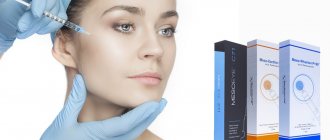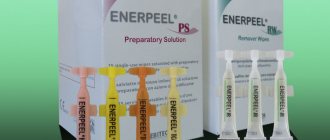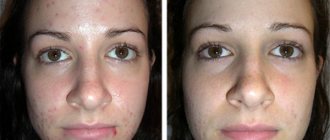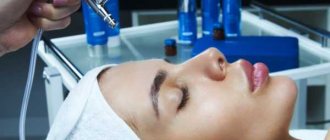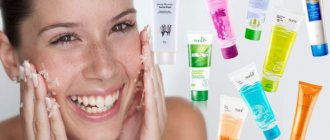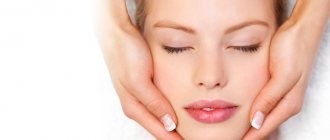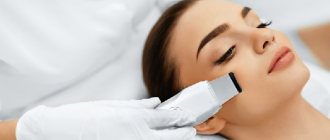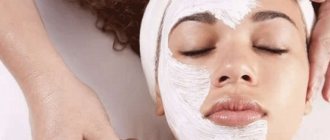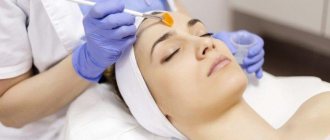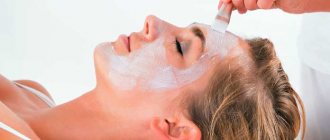From this article you will learn:
- What is acid peeling
- How much does it cost to do acid peeling for the face in a beauty salon?
- Who is recommended and contraindicated for acid facial peeling?
- Why prepare for an acid peeling procedure and how to do it correctly
- How is the acid peeling procedure performed in a beauty salon?
Today, in order to give the skin a young and fresh look, there are a huge number of different cosmetic procedures. Acid peeling for the face is especially popular among women, since it can be selected for each representative of the fair sex individually, depending on her age and type of dermis.
What is acid peeling for face
In order to understand exactly how this procedure works, you need to know what human skin is made of.
The skin consists of the following layers:
- The epidermis (top layer), which is a thin skin. It is here that many important processes occur, such as metabolic transformations, cell growth and death, and the functioning of the immune system, thanks to which the body is protected from pathogenic microorganisms and harmful bacteria.
- Next comes the dermis , which can be imagined as two balls, one of which is reticular and the other is papillary. They contain elastin and collagen, which are responsible for the elasticity and smoothness of the skin.
- The third and final layer is fatty tissue . Fat cells located between the fibers perform a protective function against hypothermia and overheating, that is, against temperature changes.
It is worth noting that each layer can be restored independently, that is, updated naturally. However, how does exfoliation revive cells?
The effect of acid peeling is always the same. During the procedure, the skin is burned, as a result of which the body activates regenerative processes leading to cell renewal.
Acid peeling in some cases can even reach the dermis, but the depth of penetration is usually selected individually in accordance with the condition of the skin and the characteristics of the body.
Read the material on the topic: Chemical peeling of the face: your skin will breathe a new breath!
Indications - Who will benefit from superficial peeling?
Superficial exfoliation is indicated in the following cases:
- Dull, uneven complexion.
- Uneven terrain.
- Sluggish, “tired” skin.
- Pigmentation.
- Small wrinkles.
- Increased sebum production.
- Enlarged pores.
- Acne.
- Photo- and chronoaging.
- Preparation for other cosmetic procedures, including medium peels and laser resurfacing.
Such peels are suitable for patients of any age, both in the presence of obvious defects and simply to improve the condition of the skin. Unlike more aggressive types of treatment, superficial peeling is suitable for sensitive, delicate skin.
Types of acid peeling for the face
Taking into account the characteristics of the procedure mentioned above, cleansing can be of three types:
- Superficial when a fairly weak acid is used (salicylic, pyruvic, lactic and other fruit acids). In this case, only the top layer of skin is removed. Sometimes such a light cleansing is enough to renew the epidermis and make the face clean, fresh, young, and remove wrinkles.
- The middle one, which involves the use of more powerful types of acids, for example, trichloroacetic or retinoic. In this case, the burn affects not only the upper layer, but also the dermis, as a result of which the effect of the procedure becomes even more noticeable. After the session, a person looks five years younger, the skin smoothes out, acquires a velvety structure, small wrinkles and damage disappear, and the relief is evened out.
- Deep. This is the most powerful type of procedure, which allows you to get rid of scars, stretch marks, chickenpox marks and other skin blemishes. For deep cleansing, phenolic acid is used, which you need to be very careful with, otherwise you can get burned. The procedure should only be carried out by professional cosmetologists within the clinic, since it is comparable to a mini-operation.
If we talk about the home version, light cleansing with fruit acids is allowed. It is used as a scrub replacement. The procedure allows you to maintain the skin in well-groomed condition. Regular course use of such cleansing at home ensures the preservation of youthful skin for a long time.
As for deep peeling, it is usually carried out only as prescribed by a specialist, most often when there are potholes on the face left by acne. At home, the best option would be a multi-acid option, which consists of several acids with a concentration of up to 25%.
Read material on the topic: Retinoic yellow peeling done by Hollywood stars
Dry cleaning
The type of chemical peeling depends on the depth of exposure of the composition.
- superficial is made on the basis of fruit acids. To achieve the best result, it is advisable to mix different acids. One session every 3-4 months is enough to maintain the effect.
- Medium peeling is more aggressive than superficial peeling, since high concentration acids are used during the procedure. Due to the deep impact on the layers of the dermis, the effect of the procedure is more noticeable and lasts longer, but the recovery period also increases. It is recommended no more than 3-4 sessions per year.
- deep is the most radical method of chemical action on the deep layers of the epidermis to remove blemishes. After the procedure, the skin is completely renewed. One session is enough for significant results.
But high efficiency comes with high risks. The procedure is not recommended to be carried out at intervals of less than 1 year.
Acids used for facial peeling
In order to get the intended result, it is necessary to choose the right type of acid, since each has a specific effect on the skin:
- Fruit acid, which is one of the weakest. Used to eliminate minor age-related changes. You can easily buy it yourself and do acid peeling for your face at home. The composition contains mangrove, grape, sugar or cane acid. Thanks to this cleansing, you can restore elasticity, firmness and tone to the skin.
- Mandelic acid, used as an antibacterial agent for facial treatment. Allows you to smooth out scars that appear after acne and acne.
- Salicylic acid. Cleansing with its use is suitable for people with dark skin, suffering from any type of seborrhea, acne and hyperpigmentation.
- Lactic acid. Allows you to make facial skin more youthful, soft and delicate.
- Retinoic acid. Peeling with its use is performed, as a rule, in cosmetology clinics and allows you to achieve a pronounced effect. Thanks to the different concentrations, it is possible to select the product individually for each patient, depending on age and existing problems. The same criterion determines the degree of burn.
- Glycolic acid. Ideal for light facial cleansing, as it refreshes the epidermis and gets rid of blemishes and rashes. In addition, it copes well with sebaceous accumulations and dirt plugs.
Read material on the topic: Fruit peeling: in a beauty salon and at home
Mechanical cleaning
Mechanical peeling affects only the surface of the skin, without affecting the deeper layers of the dermis. Therefore, it can be called a relatively gentle process. After such cleaning, the skin is cleansed of atmospheric pollutants and dead particles of the epidermis, which improves the appearance and helps speed up metabolic processes.
Mechanical skin cleaning includes:
- Brossage - this procedure is performed using a device equipped with soft brushes or sponges. Depending on the goal, it is performed with an interval of 7-1 days.
- Peeling scrubs. Recommendations for the frequency of this type of cleansing depend on the oiliness of the skin. For oily skin – weekly; for dry skin, it is recommended to repeat scrubbing every two weeks. After a course of procedures, which lasts 2 months, a break is necessary to avoid the risk of damage from thinning of the upper layers of the dermis.
- Dermabrasion is skin resurfacing. It is performed using a device with special attachments coated with abrasive particles. Most often used for certain problems that require more serious treatment. For example, scars, old scars, deep wrinkles. Breaks between sessions can last up to 6 months, since the surface layer of the epidermis is removed almost completely
- Microdermabrasion. It is also a type of skin polishing, but the treatment is carried out with attachments containing microcrystals. The number of sessions varies from 5 to 20 sessions, and the break between courses is 1-3 months.
A cosmetologist may recommend alternating procedures, since the effectiveness of one type decreases with each subsequent use.
Cost of acid peeling in the salon
As for the cost of the session, it depends on what acid was used during the procedure, its concentration, the products used after cleansing, and the region in which the clinic is located. In addition, the price is influenced by the prestige of the salon, as well as the qualifications of the specialist. However, on average, the cost of one peeling is 2,500–16,000 rubles.
In addition, the price is also affected by what type of facial cleansing was performed. For example, a superficial one will cost 2500–3500 rubles, a middle one – 3000–5000 rubles, a deep one – 5000–6000 rubles.
Peeling using trichloroacetic acid will cost about 6,000–7,000 rubles. The retinoic acid procedure is one of the most expensive. You will have to pay about 11,000–16,000 rubles for it.
Recommended articles on the topic:
- Ultrasonic facial peeling is a pleasant and beneficial procedure for your skin
- How to properly care for your skin
- How to remove wrinkles on the face: the most effective methods
Indications and contraindications for acid peeling
Acid cleansing is a universal procedure because it can be used not only on the face, but throughout the body. With its help you can get rid of stretch marks, restore skin elasticity after the birth of a child or sudden weight changes. Acid peeling is allowed from the age of 18. This procedure is very effective in caring for oily and problematic skin that is prone to acne. Often such cleansing is prescribed before biorevitalization and mesotherapy.
In what cases is acid peeling for the face recommended:
- when facial wrinkles appear;
- in case of loss of elasticity and fading;
- with deterioration of skin color and the appearance of sagging;
- in the presence of wide pores;
- for age spots;
- for dry skin and dehydration;
- in the presence of comedones;
- in case of lumpy skin and dryness.
After acid peeling, the face looks fresher and more rested, tone is restored, scars are smoothed out. If you carry out the procedure regularly, the secretion of the sebaceous glands decreases, comedones disappear and no longer appear. For dry skin, the effectiveness of manipulation lies in restoring hydrobalance and normalizing the pH of the epidermis.
Cleansing is contraindicated if:
- Skin damage such as wounds, scratches, cuts.
- Tendency to allergic reactions, which manifest themselves in the form of swelling or rash.
- Infectious diseases, for example, rosacea, herpes, ARVI, psoriasis.
- Unsuccessfully carried out ultraviolet or laser cleaning.
- Oncological diseases.
- Acute inflammation.
- Pregnancy and lactation.
For any skin, even the most problematic, you can choose a safe and gentle product, however, in each specific case, only a specialist can determine which acid peeling for the face is best.
Read material on the topic: Salicylic peeling: healing, rejuvenating, cleansing
Contraindications and indications for the procedure
Peeling can help solve a large number of cosmetic skin problems, including::
- Excess secretion of the sebaceous glands.
- Enlarged pores, comedones.
- A small amount of acne and other inflammations.
- Signs of aging – wrinkles, sagging, pigment spots.
Since exfoliation has a direct effect not only on the skin, but also on the woman’s body, it is worth studying in detail the conditions in which it is undesirable to carry out the procedure:
- Inflammatory processes.
- Active phase of acne.
- Skin diseases.
- Open wounds and other skin damage.
Particular care should be taken when approaching procedures when the condition of a woman’s body changes:
- What peelings can be done during pregnancy and is it possible to use chemical methods at all?
This question arises among women who are used to regularly exfoliating their skin, but are afraid of harming their baby. Cosmetologists advise using only gentle exfoliation methods, for example the mechanical method. It is prohibited to carry out procedures using ultrasonic and laser equipment, as well as chemical compositions with a high acid content.
- Is it possible to exfoliate during menstruation when acne breaks out?
During menstruation, the level of hormones in a woman’s body increases sharply, which is why inflammation often appears on the face. Also at this time, girls may have a lower pain threshold, and even a slight impact on the skin will bring severe pain. Therefore, cosmetologists do not recommend exfoliation during menstruation.
- When can you do peeling after cleansing your face and is it worth doing it at all?
The specificity of these procedures has a single goal - cleansing the skin and eliminating its imperfections. The combined use of both methods can have an excessively strong effect on the skin and lead to injury. It is preferable to alternate these procedures rather than carry them out together.
- Is it possible to do a mask and massage after peeling?
Since the skin is irritated after the procedure, you should not carry out additional manipulations in the first two or three days. Strictly follow the recommendations of the cosmetologist with whom you are undergoing the procedure. Often, independent attempts to improve the condition of the skin after deep cleansing can nullify the effect or lead to inflammation.
Preparing for the acid peeling procedure for the face
Regardless of whether you plan to cleanse at home or go to a salon for a deeper acid peel, it is necessary to prepare the skin.
You should start using acid products every day a month (at least one to two weeks in advance). This is necessary so that the skin gets used to such effects.
With improper preparation or lack thereof, acid peeling can be either insufficiently effective, that is, very superficial, or too deep, and therefore painful.
The best choice would be products that have a high pH level and low acid content. These can be mild pre-peelings, creams, cleansers and serums.
If these are BHA acids, then the minimum effective indicators will be 1-2% with a pH of 3-4. In the presence of comedones and severe pollution, the pH decreases and the percentage increases to 5. For AHA acids, the figures will be 5–9% with a pH of 3–4.
Read material on the topic: Almond peeling for the face: features of the procedure
Stages of acid peeling in the salon
Regardless of the type of acid facial peeling (photo above), the procedure is always the same. The only difference is the timing and degree of exposure of the skin to the acid. The session itself lasts about one hour, but the duration of the active effect on the epidermis is no more than ten minutes.
Procedure steps:
- Thorough makeup removal.
- Carrying out preparatory peeling.
- Applying acid for no more than ten minutes under the supervision of a cosmetologist.
- Using a neutralizing compound to stop a chemical reaction.
- Applying a mask with a calming effect to relieve irritation and accelerate the regeneration of damaged cells.
After the procedure is completed, the patient is given detailed instructions on how to care for the skin and select cosmetics (cream, lotion) to increase the effectiveness of the peeling.
Read material on the topic: Depigmenting peeling: everything you wanted to know about it
Skin restoration after acid facial peeling
Even if skin cleansing was performed by the best specialist using high-quality products, the procedure requires subsequent rehabilitation.
The duration of this period depends mainly on the degree of exposure to the epidermis and ranges from 7 to 14 days. The physiological characteristics of the body are also of great importance, since in some people the skin recovers faster, while in others it is slower. In some cases, the regeneration process can take more than two weeks.
Regardless of all of the above, each patient must adhere to certain rules after peeling:
- The use of creams and ointments aimed at accelerating healing (Bepanten, Solcoseryl).
- Avoid visiting saunas and steam baths.
- Provide protection from low temperatures.
- Avoid the possibility of skin injury.
- Do not use aggressive products aimed at cleansing your face.
Skin care after acid peeling should be the same as after a burn.
Read the material on the topic: How to properly care for your facial skin
Quantity, frequency and time of acid peeling procedure
Already after the first peeling session, the result is visible, that is, the skin becomes more even, fresh, smooth and velvety.
According to the recommendations of experts, in order to obtain a lasting effect, it is necessary to carry out at least 7–10 procedures. When it comes to how often to do an acid facial peel, opinions vary. Some cosmetologists claim that at least six months should pass between the first session and the second.
If deep cleansing has been carried out, the time for the next procedure will depend on the process of skin restoration, since it has a rather aggressive effect. In this case, the reaction of the dermis of each individual patient to the effects of acid, its condition and characteristics is of great importance.
As for superficial acid peeling, it can be performed more often, that is, 4-5 sessions over 7-10 days. The procedure must be repeated every 6-7 months. It is worth noting that manipulations are not performed in the summer.
Acid peeling is best done between September and mid-April. In this case, solar activity should be average, since you should try not to expose your skin to ultraviolet radiation.
Read the material on the topic: Is it possible to do peeling in the summer or is it impossible to take care of your skin all year round?
Why is chemical peeling best done in autumn or winter?
The optimal time for peeling is autumn and winter - when the sun ceases to be active. The fact is that the process of skin rejuvenation, for which peeling is done, is not completed immediately after the procedure. “New” skin, cleared of dead cells, still very thin and delicate, needs time to recover and return to normal. Until the skin is completely restored, it has increased sensitivity to ultraviolet radiation. In order not to provoke the formation of age spots, the skin should be protected from sunlight. After shallow, superficial peels, UV protection is required on average for 1-2 weeks, so they can be done even in late spring and early autumn, and after medium peeling, you need to protect the skin from the sun for up to three months.
Possible consequences of acid peeling for the face
Even if you use the best acid peels for the face with a weakly concentrated solution, it is not always possible to avoid redness, swelling and irritation. They can last for several hours (glycolic and lactic acids) or 2-3 days (salicylic, kojic, acetylsalicylic and retinoic acids).
In some cases, you may encounter more serious consequences:
- prolonged skin hyperemia (up to 8–10 days);
- persistent swelling;
- skin burn;
- increased pigmentation in the acid-treated area.
In such situations, the patient is prescribed special products that soothe the skin and restore its cells.
In order not to encounter the negative consequences of acid peeling, it should only be carried out by specialists in cosmetology clinics. When using acids at home without consulting a cosmetologist, you can get burned.
Read material on the topic: Peeling roll for the face: features of the procedure, indications and contraindications
The nuances of acid peeling for the face at home
There are different ways to perform facial peeling. In addition, today there are a huge number of cosmetics on the market that contain active acids.
- Mixtures prepared from ground strawberries, pineapple, apples and bananas are applied to the face for 20 minutes, after which they are washed off with warm water, and the skin is lubricated with moisturizer.
- Acid peels, sold in pharmacies, selected according to the age characteristics of the dermis, for example, scrubs and masks based on citric, lactic, mandelic and grape acids.
- Cleansing with natural lemon, which degreases and whitens facial skin. Apply freshly squeezed juice with a cotton pad. After 10–15 minutes, rinse with warm water and use a cream with a moisturizing effect.
- Cleansing using sour milk, sour cream or natural yogurt mixed with lactic acid (4%) and oat bran. The composition is applied for 20 minutes, after which it should be washed off.
- Grape peeling is effective for mature skin, having a tingling effect on it. This method of cleansing is not suitable for people with very sensitive skin.
If you plan to carry out acid peeling at home, it is best to use ready-made cosmetics, as well as natural products, since they are safer and do not cause burns or other complications.
To wash off acids, it is preferable to use mineral water, since it neutralizes their effect and soothes the skin.
Read material on the topic: Gas-liquid skin peeling - beauty without pain and injections
Chemical peeling of the face - renewal and rejuvenation of your skin
Home→Articles→Chemical facial peeling - renewal and rejuvenation of your skin
The chief cosmetologist at Aesthetic City, Dilyara Rafikovna Askarova, will talk about the chemical peeling procedure.
Dilyara Rafikovna, what is “chemical peeling”?
Peeling - (from the English “to peel” - to cleanse, exfoliate) is an effective cosmetic procedure based on exfoliation of the superficial, middle and deep layers of the epidermis.
If we talk about chemical peeling, then this is the effect of special chemical agents on the surface and middle layers of the skin. Chemical peeling is divided into several types: superficial, medium and deep.
Superficial peeling is the softest peeling, which affects the upper layers of the skin. During chemical peeling, the cosmetologist usually selects gentle compositions - these are fruit, lactic, glycolic, tartaric acids, etc. Indications for fruit peeling include problems with oily and porous skin, acne marks, minor age spots, and sensitive skin.
With medium peeling, the middle layers of the epidermis are affected. This type of peeling helps smooth out wrinkles, remove age spots, scars, signs of inflammation, acne, brighten and refresh skin color.
Deep peeling affects the deeper layers of the skin. It is used to correct wrinkles, scars, hyperkeratosis, and pigmentation. This procedure is usually performed in a hospital setting. At the Aesthetic City Beauty and Health Centers, specialists perform superficial and medium chemical peeling procedures.
What is the effect of the peeling procedure?
Peeling promotes skin renewal and rejuvenation. This cosmetic procedure helps get rid of age spots and various skin defects, including scars and acne marks. A course of peelings will help remove wrinkles, get rid of mild acne, tighten pores, and refresh your complexion.
In addition to improving the condition of facial skin, it is possible to work with other areas of the body. Chemical peeling of the back is carried out to get rid of post-acne, acne, and age spots.
At what age can you peel?
If the skin condition is normal, experts recommend peeling procedures for people aged 18 years or older. However, you need to keep in mind that everything is individual. For various skin problems (post-acne, age spots, skin renewal problems), a peeling procedure may be required up to 18 years.
Is it possible to do peeling if there is inflammation or acne on the skin?
It is not recommended to peel on severely inflamed skin. In this case, it is better to visit a cosmetologist who, after diagnosing the skin condition, will propose a treatment plan for acne on the face and other parts of the body. For mild acne, the peeling procedure is quite acceptable and even useful. The pores are narrowed and the skin healing process is accelerated.
How often should you exfoliate?
The facial peeling procedure can be performed once every 2 weeks. The full course ranges from 6 to 10 sessions. Peeling of other parts of the body, where the skin is thicker, can be done more often, once a week.
How is the chemical facial peel procedure performed?
First, we prepare the skin and remove facial makeup. After this, we apply a cleansing gel with glycolic acid to the skin - it removes residual fat, restores pH balance, and ensures uniform absorption of the peeling composition by the skin. It should be noted that before the peeling procedure, you should not cleanse your face with alkaline products (soap, soap gels), as they disrupt the natural pH balance of the skin; the result of peeling in this case will be ineffective.
After the cleansing procedure, apply the peeling composition to the skin for 10 minutes. During this time, frost should form on the skin (a solid white film over the entire surface of the skin). As frost appears, the specialist neutralizes the areas of the skin where the film has formed with a special composition. With superficial peeling, the composition applied to the skin is almost not felt. During medium peeling, the patient feels a slight tingling and burning sensation.
The final part of the procedure is applying skin care (cream or mask according to your skin type).
It should be noted that the full results of peeling are visible a few days after the procedure. Immediately after peeling, the skin turns slightly red due to exposure to chemical agents. At this time, it is important to properly care for her. The specialist will tell you how to do this and prescribe a recipe. At the Aesthetic City Beauty and Health Centers, cosmetologists usually make follow-up appointments with patients to check the condition of the skin. A day or two after the procedure, the skin becomes smooth, tightened and radiant. Next comes the time of abundant peeling - the skin begins to renew itself. After complete exfoliation, you will immediately feel the difference before and after peeling.
What should and should not be done before/after a chemical peel procedure?
After the peeling procedure, you need to use creams with a sun filter of 30 or more (30SPF) for 2-3 days. Exposure to the sun or visiting a solarium is not recommended.
To achieve the best results and avoid side effects, it is important to strictly follow your doctor's recommendations. The important ones are:
1. Do not remove dead or flaking skin: this may cause bleeding, discoloration of the skin or even small scars;
2. Avoid being in direct sunlight and avoid visiting the solarium, bathhouse, sauna and swimming pool;
3. For about 30-50 days (depending on the type of peeling performed), go outside only after using sunscreen. This reduces the risk of hyperpigmentation (brown spots on the face). To protect your skin, you should use a UV reflector daily;
4. Visit your doctor 2 days after the procedure: he must make sure that the recovery period is proceeding normally.
For additional information, call the unified information service of the Aesthetic City network of beauty and health centers: 555-44-44. You can sign up for the procedure in an area convenient for you using the online registration form on our website using the link here or by calling the Aesthetic City Beauty and Health Centers.
Useful video about facial peeling at home
Nowadays, you no longer have to spend a lot of time performing complex and unpleasant procedures at home. It is much easier to seek help from real professionals - the Veronika Herba beauty and health center, equipped with effective and modern equipment.
Why clients choose Veronika Herba Beauty and Health Center:
- This is a beauty center where you can take care of yourself at a reasonable cost, while your face and/or body will be treated not by an ordinary cosmetologist, but by one of the best dermatologists in Moscow. This is a completely different, higher level of service!
- You can receive qualified help at any time convenient for you. The beauty center is open from 9:00 to 21:00, seven days a week. The main thing is to agree with your doctor in advance on the date and time of your appointment.
Sign up for a consultation with a specialist by phone +7 (495) 085-15-13
, and you will see for yourself!
Hardware cleaning
Hardware peeling is performed using laser or ultrasound. Suitable for correcting even the most sensitive areas. The procedure itself is less traumatic, so the recovery period does not take much time.
This type of peeling can be used with a break of 3-4 months to maintain the achieved result.

